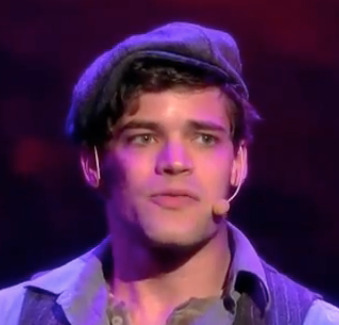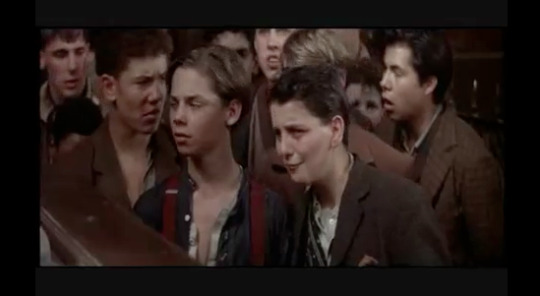Link
Want to do something to preserve David Jacobs history in New York City? Just an angry kid with no money? Help Preserve the Lower East Side Tenement Museum (a place teaming with enough history to write several accurate fan fictions)! Just click to vote - every day until May 21st. The top 4 highest voted historical places get funding, so let's make one of New York: A Newsies Experience favorite spots one of the top 4!
30 notes
·
View notes
Text
And This so Called Headline...
Trolleys are the unsung, unseen characters in the movie Newsies. After all it is the Trolley strike, the one that Pulitzer ranted dragged on forever, which probably inspired the newsboys to go on strike in the first place.
The history of the trolley car in New York is oddly complicated. The date of origin for the trolley car is hard to decipher as trolley car, cable car, and sometimes streetcar are used interchangeably in several documents. To clarify, cable cars were powered by steam driven machinery and trolley cars were run by electricity. The first cable car line was open in New York City in 1883. At some point, shortly after but before 1905, trolley cars became the popular method of transportation. Streetcars seem to be any type of car functioning as a mode of transportation.
Back in 1899, a newsboy might have sold to streetcar passengers regularly. It might have been a great way to make extra money as the boys’ cheated people out of their change by pretending (or not pretending) to be unable to keep up with the moving streetcar. Not to mention, a newsboy sick of enjoying nature (or walking) might have hitched a ride on one of the trolleys. By the 1950s, Trolley cars had been replaced with motorbuses on the streets of New York City.
Unfortunately for the modern day newsy there are no trolley cars to hitch a ride on or to raid for the business opportunity of peddling papers. But there is a New York Transit Museum in Brooklyn, where visitors can actually see the exhibit On the Street: New York’s Trolleys and Buses. It’s an interactive experience detailing 175 years of public transportation in the city. Also all travelers can see a child size trolley in the display.
Additionally, if our travelers are leaving the warmth of the city there is an actual Trolley Museum of New York located in Kingston (about 2+ hours outside of Manhattan by car). And if you find yourself with a headline about the trolley strike, remember headlines don’t sell paper…. Newsies do.
By Laces, 2012.
4 notes
·
View notes
Quote
Down the street, a trolley is in flames, surrounded by a mob of shouting men. David looks at it nervously.
-Newsies Script, 1992.
11 notes
·
View notes
Text
City Hall
Located in City Hall Park, New York’s City Hall is an impressive edifice. Built between 1803 and 1812, it is one of the oldest continually used City Halls in the nation that is still used for its original governmental function. Although it makes virtually no appearance in the movie, in reality its three-story marble façade would have overshadowed Newsies Square, where our newsboys were pelvic-thrusting their way to victory. One can imagine Les entreating the Mayor to “Buy me last pape, Mister?”
While visiting City Hall, you may be tempted to protest Mayor Robert Van Wyck’s treatment of the newsies’ strike. Van Wyck was not up for reelection in 1899, despite Pulitzer using that as a bargaining chip in the movie, but his term was beset by political scandal. A state legislature investigation in 1899 concluded that the Mayor was a “dictator” who “abdicated” his powers to Tammany Hall bosses.
Van Wyck probably would have felt betrayed by Pulitzer when, a year later, the New York World revealed his involvement in the “Ice Trust” scandal. Van Wyck and other politicians provided political protection for the American Ice Company’s monopoly over ice distribution in the city and their plans to double the price of ice—a dangerous decision in a time when the populace depended on ice to keep their perishable food from spoiling. Perhaps it made a good headline for our newsies—although as we all know, a crooked politician, “ain’t news no more.”
Sadly, City Hall is currently under renovation and tours into its truly impressive interior have been postponed until further notice. Be sure to check out the back of the building, though. When City Hall was built, it was so clearly at the City’s northern edge that the rear of the building was faced with brownstone, cheaper than the marble used on the rest of the building. No one would see it, right? But by the time Jack and the gang were singing and dancing, the city had extended well past City Hall.
By Stray, 2012.
3 notes
·
View notes
Text
At the Train Yards
For Jack, trains were the freedom to escape his life and pursue his dreams out in Santa Fe. But what train to use? If he’d wanted to ride in comfort, a passenger train on the New York Central Railroad out of Grand Central Station would have been the answer. The more economical solution, however, would have been to hop a New York Central freight train.
The west side rail lines are well known today because of the High Line Park, perhaps the City’s most famous park—next to Central Park, of course. But the elevated lines that comprise the High Line didn’t exist in 1899. Up until 1929, New York Central freight trains ran on street-level tracks down 11th Avenue to 34th Street. Because of fears that the trains might explode, at 34th Street, where the tracks curved and continued down 10th Avenue, a “dummy engine”—a steam engine enclosed in a wooden box structure—was attached to take the trains the rest of the way to the freight depot at Beach and Varick Streets.
Not only would jumping a freight train have been cheaper for Jack, there was also another aspect of the west side railroads that would have appealed to him: the West Side Cowboys.
It turns out that running freight trains on street-level through a city is actually quite dangerous. Who knew? Accidents between freight trains and street traffic were so frequent that 10th Avenue became known as Death Avenue. To help prevent these, men on horses, called the West Side Cowboys, rode in front of the trains, swinging red lanterns to warn pedestrians and other traffic out of the way.
The High Line did not open until 1934. Although today only a part of the original tracks remain, when it opened, the High Line ran from Spring Street to 34th Street through the center of blocks rather than directly over the avenue, and eliminated street-level railroad crossings. It closed in 1980, where it rusted for over 20 years until being converted into an elevated park in the late 2000s. Today, thanks to the High Line, you can play frogger with cars, not trains, on 10th Avenue.
Even though it’s off the beaten path, the High Line is well worth the excursion; it’s a fantastically cool park. You may not see any West Side Cowboys, but you will get a great view of City and the Hudson River.
By Stray, 2012.
1 note
·
View note
Photo

Just hold on here, until that train leaves Santa Fe...
Jack Kelly, Newsies the Musical. Papermill, 2011.
4 notes
·
View notes
Text
Speak Softly & Carry a Large Stick
Sometimes, I fear I might have an unhealthy love for Teddy Roosevelt and possibly none of it comes from him being the 26th president of the U.S.A. The Teddy Bear might have a lot to do with my giddy delight in him, or maybe it’s his being an accomplice to the escape of one Francis Sullivan from the House of Refuge. Truthfully, Teddy Roosevelt might just be one of those big personalities, a character in history hard to ignore and even harder not to just love. Aside from being president: Teddy published books, was awarded the medal of honor (though belatedly in 2001), was awarded a Noble Peace Prize, and managed to be a cowboy! But his importance to us comes from an odd mix of fictional and factual accomplishments.
There are 8 mentions of Teddy Roosevelt in the movie Newsies. Not to mention the Governor’s prominent role as the hero of the day when he shows up in the stage and film renditions. Colonel Roosevelt was the vehicle, though unbeknownst to him, that helped Jack escaped the Refuge and then became the driving force to end the strike. Historically, TR did not have anything to do with the newsboys’ strike of 1899. But even without a direct involvement to the strike, Roosevelt was still a prominent figure for the boys. The Roosevelt family was heavily involved in the Children’s Aid Society, the organization responsible for establishing the lodging houses (outside of the Catholic ones). Actually Theodore Roosevelt Sr. not only helped found CAS, but also regularly attended Sunday night dinners at No.9 Duane. Around 1880, Colonel Roosevelt took over responsibilities with CAS from his father. By the time of Kid Blink and Racetrack Higgins, Teddy was a well-recognized war hero and champion of working classes.
Yes, Jack. We’ve all heard of Teddy Roosevelt. Really Kelly, you couldn’t have picked a more famous individual of your time to hitch a ride from for your escapade. Every newsies traveling to the city should take a moment to visit The Theodore Roosevelt Birthplace, a national historic site. The only U.S. President to be born in New York City, the Victorian reconstruction (the original was demolished in 1916) of his boyhood home now serves as a museum. Today, we can walk through rooms echoing of a time long forgotten (1865) and see actual artifacts from the Roosevelt family. The period rooms can only be viewed by tour, with tours leaving every hour except for noon. Please be advised tours are limited to 15 people and last approximately 30 minutes each. If you are traveling with your very own lodging house (aka a group of 10 or more) you must call in advance to schedule a tour – (212) 260-161. Go on then in the words of Teddy himself, speak softly and carry a big stick (though on that note, I should mention Colonel Roosevelt detested being called Teddy… watch your head).
By Laces, 2012.
1 note
·
View note
Quote
A large room filled with boys sleeping in hammocks,
including JACK KELLY, snapping his fingers in his sleep.
On the wall by his head, the commanding visage of Teddy
Roosevelt grins down from a rotogravure photo.
- Newsies, Yellow Script 4/8/1991. Taken from Definitive Newsies Resource.
3 notes
·
View notes
Quote
When I got sent up, me and this kid, like Les, but younger, we busted out. Teddy Roosevelt was Police Commissioner then. He was goin' around....
-Jack Kelly, The Original Newsies Script from Relic
1 note
·
View note















